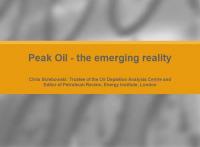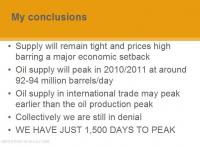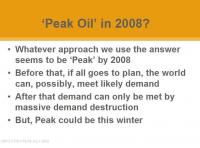28 Aug 2006
ASPO 5. Skrebowski tells us there’s 1,500 days until the Peak, & closing thoughts on ASPO 5.
**Chris Skrebowski. Peak Oil and the Emerging Reality.**
 *Chris is the editor or Petroleum Review and is a well known speaker on peak oil. He also uses very detailed Powerpoint presentations which he zips through so fast that comprehensive note taking is nigh on impossible! You can find his powerpoint here, which is well worth a read, as he is a challenge to even the most dedicated note taker! Here’s what I got down from his talk, for which I make no claims of completeness (it was very hot in that tent!)*
*Chris is the editor or Petroleum Review and is a well known speaker on peak oil. He also uses very detailed Powerpoint presentations which he zips through so fast that comprehensive note taking is nigh on impossible! You can find his powerpoint here, which is well worth a read, as he is a challenge to even the most dedicated note taker! Here’s what I got down from his talk, for which I make no claims of completeness (it was very hot in that tent!)*
 Decoding the figures in the new IEA report is akin to decoding the Da Vinci Code. In my work I am not a pessimist, and I observe what oil companies do, not what they say. Peak oil is the point where further expansion of production becomes impossible. The world needs oil production *flows*, the consumer needs delivery flows, reserves are no use as reserves, only as flows, peak oil is when flows can’t meet required demand, this is an economic scenario. An example is the Alaskan North Slope, once you leave the plateau of production you are always in decline.
Decoding the figures in the new IEA report is akin to decoding the Da Vinci Code. In my work I am not a pessimist, and I observe what oil companies do, not what they say. Peak oil is the point where further expansion of production becomes impossible. The world needs oil production *flows*, the consumer needs delivery flows, reserves are no use as reserves, only as flows, peak oil is when flows can’t meet required demand, this is an economic scenario. An example is the Alaskan North Slope, once you leave the plateau of production you are always in decline.
Oil powers 80-95% of all transport, 50-75% of all oil is used for transportation, 99% of all lubrication is done with oil products,
95% of all goods in the shops get there using oil, 99% of our food involves oil or gas for fertilisers, agrochemicals, tilling, cultivation and transport. Oil is the most important source of primary energy on the planet accounting for 36.4% of all energy. What do current high oil prices tell us? The market is saying ‘send more oil!’. Economics need a balance of supply and demand, they assume that high prices bring new demand, yet high prices have failed to bring any new supply to meet this demand. In the Third World, high oil prices are already having a huge impact.
Demand is now starting to come down to reach supply. So why are supplies peaking? We are not finding enough new oil. We are not developing new fields fast enough, our old fields are getting very tired. In 2005 we found 5 bn barrels, and we used 30 bn, a ratio of 6:1.
 Developing new fields is a slow process. Alaska for example has no roads, no licensing, no infrastructure. It will take at least 25 years until it is in production. Angola was licensed this year, but it will take 5-6 years to come on line. Of the 18 largest fields in production 12 are now in decline, 5 have some potential, 1 is undeveloped. The 120 largest oil fields give 50% of total world oil production, and 70% of production comes from fields more than 30 years old. Like a nation long into a war, we are relying more and more on young men and old boys.
Developing new fields is a slow process. Alaska for example has no roads, no licensing, no infrastructure. It will take at least 25 years until it is in production. Angola was licensed this year, but it will take 5-6 years to come on line. Of the 18 largest fields in production 12 are now in decline, 5 have some potential, 1 is undeveloped. The 120 largest oil fields give 50% of total world oil production, and 70% of production comes from fields more than 30 years old. Like a nation long into a war, we are relying more and more on young men and old boys.
According to his year’s BP statistics, OECD production peaked in 1997,non-OPEC production peaked in 2002, North America and Mexico peaked in 2000, and are in a 19.2% decline. While economists live in a fantasy world, we have to look at realities here.
 The reality of the North Sea is that it peaked in 1999. Norway peaked in 2001. While the North Sea peaked in 200 it is already down by 20%. The Forties field was discovered in 1975, experienced a ragged peak, and the use of enhanced recovery just led to a very small ‘tick’ at the end of the depletion curve. Do not believe anyone who tells you that enhanced recovery will make any difference to depletion!
The reality of the North Sea is that it peaked in 1999. Norway peaked in 2001. While the North Sea peaked in 200 it is already down by 20%. The Forties field was discovered in 1975, experienced a ragged peak, and the use of enhanced recovery just led to a very small ‘tick’ at the end of the depletion curve. Do not believe anyone who tells you that enhanced recovery will make any difference to depletion!
Oil companies are now struggling to hold onto their positions. The top 5 decliners now are the US, Norway, UK, Syria and Iran. In 2005 the world added 2.581 mnbd capacity.
 The Megaprojects report I have produced is not made up by me, it is an analysis of publicly available data, anyone could do it. There are a number of things that affect when peak oil could occur. One is project slippage, currently running at around 20% each year. Companies are always optimistic, meaning you can ad around 10% onto their time forecasts. The result is that depletion is running at 1.2 mnb/d and is rising. Enhanced recovery makes no big difference. Depletion rates are rising and 90% of known reserves are already in production.
The Megaprojects report I have produced is not made up by me, it is an analysis of publicly available data, anyone could do it. There are a number of things that affect when peak oil could occur. One is project slippage, currently running at around 20% each year. Companies are always optimistic, meaning you can ad around 10% onto their time forecasts. The result is that depletion is running at 1.2 mnb/d and is rising. Enhanced recovery makes no big difference. Depletion rates are rising and 90% of known reserves are already in production.
He then presented various scenarios, but felt that having taken all the possibilities into account, the most likely date is late 2010, give or take 2 years each side. There are of course a number of wild cards that could affect this. If Iraq were to settle down more oil could come on stream, but this requires peace now, which is not going to happen. Iran is now struggling to hold its production.
 So what can we do? We need a mixture of biofuels, efficiency, heavy oil and tar sands and a nuclear renewal. Supply will be tight and the price will remain high. Peak will occur between 2010 and 2011, at 92-94 million barrels a day. We are still in denial of this, but the fact is that we only have 1,500 days until the peak. The new EIA report says the same thing, although couched in caveats and provisos.
So what can we do? We need a mixture of biofuels, efficiency, heavy oil and tar sands and a nuclear renewal. Supply will be tight and the price will remain high. Peak will occur between 2010 and 2011, at 92-94 million barrels a day. We are still in denial of this, but the fact is that we only have 1,500 days until the peak. The new EIA report says the same thing, although couched in caveats and provisos.
**Thoughts and Reflections.**
Chris is a very good speaker, I already heard him once a year or so ago. What is fascinating about Chris’s research is that he uses a completely different methodology to Colin Campbell, but comes up with the same date of peak. Very enjoyable and highly informative. Using the idea of 1,500 days is a very good way of focusing the mind, given the time since his talk, it is more like 1,460 by now. It was a shame that he offered so little insight into alternatives, but I guess we can’t have everything. Tar sands and nuclear, well you know by now **Transition Culture**’s perspective on those.
So, this has been the last of my ASPO write ups. I hope you have enjoyed them. I had a great time, very illuminating. Tanti auguri to Ugo and the team who pulled it off. It was very professionally done, and maintained an air of being relaxed despite whatever chaos might have been reigning back stage! The Slow Food supper on Saturday night was one of the best meals I have ever eaten. I never knew one human being could eat so many courses at one sitting.
I did feel that the conference could have benefitted from breaking away a bit from the “bums on seats, experts on podium” model. A few breakout sessions would have enabled more networking, and allowed a more educational time for those of us who find modelling utterly tedious and generally incomprehensible. Breakout sessions, Open Space, World Cafe, these kinds of things would have enabled us to get to know each other, of the 200 or so people there, I guess I only really had good chats with about 20, a real missed opportunity given the calibre of the participants who travelled a long way to be there.
Perhaps ASPO 6 in Ireland might experiment with new approaches and techniques for facilitating useful networking. Certainly some more imaginative speakers on mitigation would be good, and a bit less on modelling, but that’s just me. Modelling is hard work at the best of times, but in 38 degree heat is tortuous. Might it be too much to expect that at ASPO10 in Totnes in 2011, the most often overhead phrase, rather than the “according to my model” that predominated the lunch queues of ASPO5, might be “I’ve got these great solar panels” or “you know, I never knew I could grow so much food in my garden”?
The seeds are there, it’ll be interesting to see which way ASPO 6 moves, towards more stuff about nuclear and tar sands, or more towards renewables and so on. Can it really sit on the fence indefinitely? I’d refer you back to an earlier piece at **Transition Culture**, which argued that organisations like ASPO need to also look beyond the peak, or risk becoming irrelevant. For now, it is certainly a fascinating broad church of eclectic characters and schools of thought. Roll on ASPO 6!
Paul Clarke
28 Aug 4:19pm
“Using the idea of 1,500 days is a very good way of focusing the mind, given the time since his talk, it is more like 1,460 by now”.
I tend to see the 2012 London olympics as a good benchmark. I think we’ll gradually see several indicators over the next few years such as construction being way over budget to fans not being able to afford the airfare.I reckon these could be the first high profile “event” thats noticeably hit by peak oil
Here’s What I Think… - about Stocks, Investing, Energy, Computing, Our Warming Planet and the News » ASPO 5. Skrebowski tells us there’s 1,500 days until the Peak
29 Aug 3:08pm
[…] ASPO 5. Skrebowski tells us there’s 1,500 days until the Peak Posted by whs Published on 28 Aug 2006 by Transition Culture / Energy Bulletin. Archived on 28 Aug 2006. […]
jeff aitken
30 Aug 1:00am
Thanks for the suggestions of Open Space and World Cafe as networking processes at the next ASPO. I see that Open Space was used in developing the leading edge Kinsale project. I’m a facilitator in San Francisco and have been involved in Sonoma County energy descent organizing. Thanks for this report from the hot tents.
Oil Shock
30 Aug 3:33am
I think the peak already happened. Dec 2005 is the peak so far. Price was mid 50s for a barrel then and 70s most 2006. Has the market stopped working ? I might be premature. But I am with Ken Deffeyes.
gylangirl
2 Sep 11:55pm
In May 2006 Colin Campbell’s blog stated we had already hit peak. Now he’s quoted in other media as saying… 2010? As in the early 70’s, is demand reducing to delay predictions of peak?
Posting any info, when available, on ASPO 6 would be appreciated.